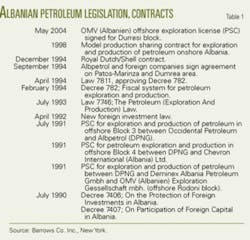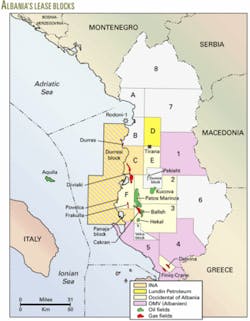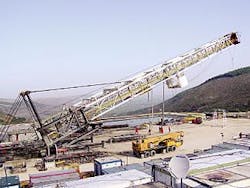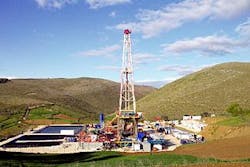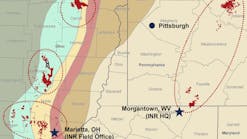DRILLING MARKET FOCUS: Albania continues to attract international operators
A new redevelopment project in the Patos-Marinza oil field is keeping attention on the Balkans.
Albania, in southeastern Europe, has petroleum resources both on and offshore, and shares geologic trends with the neighboring Balkan states of Croatia; Serbia and Montenegro; Macedonia; and Greece. The country has licensed drilling to American, Austrian, Canadian, Croatian, Greek, and Swedish companies only in the last 15 years.
Albania’s Adriatic and Ionian sea offshore resources have been only lightly explored. But the country harbors one of the largest onshore oil fields in Europe, Patos-Marinza, discovered in 1928.
The former state oil and gas company of Albania, the General Directorate of Oil & Gas, DPNG, Patos, drilled thousands of wells onshore. In 1992, DPNG morphed into state-owned Albpetrol ShA. Headquartered in Patos, Fier district, Albpetrol controls 46 energy and petroleum-related enterprises.1
After 40 years of isolation, repression, and underdevelopment due to the catastrophic economic policies of communist party leader Enver Hoxha, Albania was the last European country to emerge from communist rule. It began the transition from a centralized to an open-market economy in 1991. A democratically elected government took office in April 1992 and began economic reform programs in the predominantly Islamic nation.
An important law meant to attract and protect foreign investment was enacted on Nov. 2, 1994-Law No. 7764, “On Foreign Investments.” This guards against nationalization or expropriation of assets and allows funds to be freely transferred in and out of the country (Table 1).
Anarchy in early 1997 alarmed international investors. New elections in June 1997 settled the mood, and a popular referendum on Nov. 28, 1998, established Albania’s current constitution.
Albania’s population in June 2002 was about 3.1 million, slightly fewer than Houston. Albania spans 28,748 sq km, slightly larger than Maryland, and smaller than Belgium.
Albpetrol administers about 12 oil fields, in the Saranda, Vlora, Mallakaster, Fier, Lushnja, and Kucova districts. According to a World Bank report, 4,666 oil wells have been drilled, of which 3,123 wells are operating and 981 wells are shut in or abandoned.2
Foreign investment
Albania’s oil production peaked in 1975 and then declined until 1982, when a more rapid decline set in, due to lack of funding for field development and technical expertise.2
Still, until 1989, Albania was a net exporter of petroleum products. But by 2001, the country was importing 73% of what it consumed. Albania made efforts in the 1990s to attract foreign capital and technology, offering access first to offshore acreage and then two onshore licensing rounds. In 1990, DPNG offered contracts on offshore blocks to various international companies: Deminex Albania Petroleum Gmbh, Chevron International (Albania) Ltd., Occidental Petroleum Corp., Hamilton Oil (Albania) Corp., and AGIP SPA (OGJ, Apr. 20, 1992, p. 120).
In 1993, legislation finally opened up onshore concessions.
The first international onshore licensing round in 1992 offered access to seven onshore fields: Patos-Marinza and Kucova (Miocene sands); Visoke, Ballsh, Gorisht-Kocul, and Cakran Mollaj (fractured Cretaceous-Paleocene limestone); and Delvina (fractured limestone). Several fields required enhanced oil recovery (EOR) projects. A field data package was available for $60,000 from Petroconsultants SA in Geneva, and the bids were due Nov. 30, 1992 (OGJ, July 20, 1992, p. 40).
The second licensing round opened on Nov. 28, 1995, at a seminar in London attended by 30 oil companies. The Albanians offered two onshore blocks (A, D) not taken in the first licensing round, eight new onshore blocks covering a total of 22,400 sq km, and one block in the Adriatic Sea that had been relinquished by Agip (OGJ, Oct. 30, 1995, p. 22).
Albania received bids for the second round in mid-1996.3
Natural gas production in Albania declined to 76 ktoe in 2001 from 206 ktoe in 1990, a 63% drop (ktoe = thousand tonnes oil equivalent). Of the 500 gas wells drilled around the country, only 255 have produced gas.2 There are several defined gas fields (north to south): Durres, Ballai, Diviaki, Povelca, Frakulla, Cakrun, Panaia, Delvina, and Finiq-Crane.
In 2004, Albania had 339 km of gas pipeline and 207 km of oil pipeline. Through the end of 2005, the country had two operating refineries (Fier and Ballsh), capable of producing 26,300 b/d of petroleum products.
Offshore, historical
Foreign oil companies became involved off Albania in 1991, spending about $80 million to shoot seismic and drill three wells in the first 4 years.4
Occidental came to Albania in 1991 and has unsuccessfully drilled in the Adriatic twice, once on its own and once in partnership with OMV (Albanien), a subsidiary of Austria’s OMV AG.5
A consortium of Occidental, Agip-Albania BV, and BHP Billiton Ltd. drilled four more wells offshore in 1995-96.
French independent producer Coparex International SA, Albania Shell (Exploration & Production) BV, and INA Industrija nafte dd, a subsidiary of Croatia’s INA Naftaplin group began drilling in 1996.4
In January 2002, Stockholm’s Lundin Petroleum AB agreed to purchase Coparex International from BNP Paribas and affiliates for $172.5 million in cash, presumably for production assets in Tunisia, France, Netherlands, Indonesia, and Venezuela.
The acquisition of BNP Paribas’ 95.3% stake in Coparex was completed on Sept. 19, 2002, and an additional 3.7% stake was acquired by Sept. 30.6
Offshore, recent
In August 2005, Albania’s Council of Ministers ratified a new production-sharing contract for the offshore Durresi block, between the government, Lundin Petroleum, and OMV.
The Durresi block covers 4,200 sq km off Albania between Cape Rodoni to the north and the Karaburuni Peninsula to the south. Most of the block is in shallow water, 0 to 100 m deep, reaching a maximum water depth of 250 m in the southwest.7
A decent 2D seismic grid, acquired over the block in 1991-93, was to be reprocessed by Lundin and OMV.
Four wells were drilled offshore in 1993-94; Agip’s A4-1X had oil and Occidental’s Alban-1 turned up some gas. OMV’s Rodoni-1 gas discovery is just outside the northeast corner of the Durresi block.
According to Lundin Petroleum’s third-quarter 2005 report, issued Nov. 16, the company plans to complete a 400 sq km 3D seismic survey on the Durresi block before the end of the year. The data will be processed and interpreted in 2006, and drilling will commence in 2007.
The work program includes a 4-year first exploration period (FEP), a 1-year second exploration period (SEP), and a 2-year third exploration period (TEP).
During the FEP, Lundin and OMV must:
• Reprocess a minimum of 1,000 km of 2D seismic.
• Acquire at least 400 sq km of 3D seismic.
• Drill one or two exploration wells (if only one hole is drilled, the partners must relinquish 35% of the lease acreage).
During the SEP, the partners must acquire a minimum of 300 sq km of 3D seismic, and then relinquish 20% of the block area at the end of the SEP.
During the TEP, they must drill at least one exploration well.
Onshore, 1928-2000
The Patos-Marinza heavy oil field was discovered in 1928 in south-central Albania and is one of Europe’s largest onshore oil fields. The field is 20 km inland from the Adriatic coast and covers about 44,000 acres. It has been producing since the late 1930s, with peak production reaching 13,000 b/d by the early 1960s. Albpetrol drilled about 2,500 wells over the life of the field.
On Aug. 17, 1994, Albpetrol signed an agreement with Britain’s Premier Consolidated Oilfields PLC to form a new joint venture company, Anglo Albanian Petroleum Ltd. (AAP), to exploit enhanced oil recovery techniques in the older fields. Each party had a 50% share, to operate two onshore license areas-a 44,170-acre block that included Patos-Marinza, Albania’s largest oil field, and a 97,680-acre block that included the Dumre field discovery (OGJ, Sept. 12, 1994, p. 42).
In 1995, Houston’s Fountain Oil Inc. negotiated with Albpetrol to establish a joint venture to redevelop Gorisht-Kocul oil field in western Albania, near the Adriatic port of Vlora. Fountain Oil was designated as operator and charged with finding financing for field redevelopment and providing EOR equipment.
The field was producing about 1,200 b/d from 160 wells in 1995. Remaining reserves were pegged at more than 22 million bbl. Start-up was slated for early 1996 (OGJ, Oct. 30, 1995, p. 22).
In 1997, Premier Oil farmed out part of it’s 50% interest in the Dumre exploration license to Germany’s Preussag Energie GMBH (17.5%).8
In 2000, Premier Oil announced it was withdrawing from Albania, leaving the future EOR plans for the Patos-Marinza field in jeopardy.
In June 1998, Occidental Petroleum of Albania (onshore-2) and partners were awarded onshore Blocks A, 2, and 3, but force majeure was declared in December 1998, due to deteriorating security conditions in neighboring Yugoslavia. In mid-April 2000, they resumed activity in Blocks 2 and 3 but retained force majeure on Block A.
OMV was awarded Blocks 1, 4, and 5 and had also declared force majeure, but resumed its activities in July 2000. OMV farmed out 49% in all three blocks to Hellenic Petroleum SA. In mid-2000, it began a seismic survey on Block 5.
Australia’s Drillsearch Energy Ltd. operated the Cakran-Mollaj and Ballsh-Hekal onshore oil fields. On Aug. 31, 1998, the company announced a contract to sell all production from both fields to Albpetrol. It also said that its maximum production cost in Albania was $3.75/bbl.
Drillsearch had raised heavy oil output to 1,200 b/d, until it shut down operations under force majeure. Drillsearch also had an oil sales contract dispute with Albpetrol, which still owed $759,318 to Drillsearch in early 2000.
In late 2000, Occidental (50%) joined with Lundin Albania (20%) and US-owned Forest Oil Corp. (30%) to drill a $16 million, 4,700 m-deep well. The Block 2 location was in Mbrezhdan, in the Berat region, about 112 km southeast of the capital, Tirana. The Shpriagu 1 well was spudded in late November 2000 and took about 6 months to drill.5
It was Occidental’s first onshore well in Albania, and Lundin Oil’s first well in the country. CEO Ian H. Lundin said in a press release, “We are happy to be in Albania for a number of reasons...favorable fiscal terms, excellent access to European markets and...important oil reserves.”
Reorganization, treaties
In 1998, due to losses in Albpetrol’s upstream operations, the company’s supervising council approved plans to reorganize into three divisions under Albpetrol Corp. (APC): Albpetrol Sh.A. (exploration and production); ARMO Sh.A. (Albania refining and marketing of oil); and SERVECOM Sh.A. (service of oil companies).9
Meanwhile, the country continued to integrate into the financial life of the region.
On Sept. 19, 1999, Albania officially joined the Interstate Oil and Gas Transport to Europe (INOGATE) program.10 On Feb. 14, 2000, it was the first of 21 countries to ratify the umbrella agreement, which synchronized the interests of the member countries in providing a legal, secure, and profitable environment for foreign investment in interstate petroleum transportation system infrastructure. The first large-scale project was the Albanian-Macedonian-Bulgarian oil (AMBO) pipeline.
On May 2, 2003, in the Albanian capital city Tirana, Albania joined with Croatia, Macedonia, and the US in signing the Adriatic Charter, pledging their commitment to NATO values and furthering their petitions to join NATO.11
Croatia’s interests
Croatia’s INA Group is a holding company that controls Croatia’s oil and gas exploration, production, transportation, trading, refining, and retailing. INA is based in the capital, Zagreb, owns 38% of JAFTA JANAF, with its oil pipelines; and has Crosco as a subsidiary. The INA Group was wholly state-owned until privatization legislation was passed in 2002 and bids tendered and contracts signed in July 2003. Hungary’s Mol acquired 25% of INA for $505 million. Croatia retained 25% plus one share.
In 1996, Albpetrol signed an agreement with INA-Naftaplin of Zagreb, Croatia for oil and gas exploration and development on the Panaja-Vlore block in Albania. INA-Naftaplin is focused on exploration and production in Croatia and has minority interests in several producing fields in Block 1 and Block 3 off Angola.
In Albania’s Panaja-Vlore block, INA-Naftaplin agreed to invest $4.7 million from 1996-2000 (OGJ, Nov. 11, 1996).
Albpetrol and INA-Naftaplin drilled a wildcat on the Panaja block in early 2003.
Crosco rigs
Crosco Integrated Drilling & Well Services Co. Ltd., a drilling and well services contractor based in Zagreb, Croatia, has provided onshore drilling and oilfield services in the Albanian market since 1994. The company has worked for four international operators in Albania: Premier Oil; Occidental of Albania Ltd., a subsidiary of Occidental Petroleum Corp.; INA-Naftaplin; and OMV Albanien, a division of Austria’s OMV.
In 1994-95, Croatia’s Crosco Integrated Drilling & Well Services Co. Ltd. drilled its record onshore Dumre well in Albania, to 6,119 m (20,075 ft), with Rig E-605.
In 2000-01, Crosco used its 2,000-hp Emsco rig 603 to drill the Shpriagu 1 exploration well in onshore Block 2 for Occidental and Lundin (Fig. 1). The well was planned to 4,750 m depth, but ultimately drilled to 5,333 m.
Mike Oldenburg, Occidental’s drilling manager, said, “The well reached the limits of casing design” and was technically difficult to execute. They also encountered H2S during testing.12
On Aug. 2, 2002, Crosco announced that it would provide a National 403 1,600-hp drilling rig to INA-Naftaplin to drill the Dajlani-1 well in the onshore Panaja block, in the southwest part of the country, about 20 km from Vlora.
On May 16, 2003, Crosco announced a contract with OMV Albanien to provide a National 403 1,600-hp drilling rig for OMV’s Palokastra-1 well in onshore Block 4.
On Sept. 22, 2004, Crosco announced that it had a contract with OMV Albanien to provide a National 801 3,000-hp drilling rig and H2S services for OMV’s onshore Kanina-1 well.
Earlier this month, Crosco told OGJ that it no longer has rigs working in Albania.
Patos-Marinza redevelopment
Albpetrol and Premier Oil formed Anglo Albanian Petroleum Ltd. (AAP) in 1994, which operated the Patos Marinza field until Premier withdrew in 2000. Outside partners included Preussag Energie GMBH (subsidiary of Germany’s metal giant Preussag Aktiengesellschaft) and Intl Finance Corp. (IFC).
Calgary-based Simmons Drilling (Overseas) Ltd. drilled 13 new wells from two pads for AAP during first-quarter 2003. Simmons VP Lawrence Pasiechnyk told OGJ they used a triple drilling rig in the Marinza field, but the rig left Albania when AAP finally relinquished interest in the field by early 2004.
From August 2001 to May 2004, Richard Wadsworth served as senior development and facilities engineer, technical director, and project manager for AAP.
Enter Bankers Petroleum Ltd. (BPL), a Calgary-based company that has gone through several reincarnations since 1983. Wadsworth left AAP and became president and director of BPL in June 2004.
One of BPL’s two main subsidiaries, Saxon International Energy Ltd., maintains an office in Fier, Albania.
After AAP relinquished the rights to the Patos Marinza heavy oil field, BPL subsidiary Saxon International negotiated a petroleum agreement directly with Albpetrol, which holds the license agreement with the National Petroleum Authority of Albania (NPA) to operate the field. Saxon has until January 2006 to propose a plan of development (PoD) to Albpetrol and the NPA. Saxon also had a $2 million minimum work commitment to workover 12 wells and a water-disposal well, which it met by the end of December 2004.
Saxon has contracted for workover rigs from Simmons Drilling. Simmons has three single and two double workover rigs in Albania at this time.
By using its cold heavy oil production with sand recompletion program (CHOPS, a technique used widely in Canada’s oil sands), with progressive cavity pumps, Saxon increased production to about 1,500 b/d by the end of 2004 and reached 2,300 b/d by early December 2005, Wadsworth told OGJ (OGJ Online, Dec. 8, 2005).
If the NPA accepts Saxon’s PoD, Saxon will earn a 25-year production license. The company would then take over other sectors of the field and recomplete 600-900 wells using progressive cavity artificial lift systems. Saxon would also construct roads, treatment facilities, and a pipeline.
Saxon predicts workover or plug-and-abandon (P&A) expenses at 662 net proven wells or 947 net proven-plus-probable wells. The company estimates $25,000/well P&A expenses, and $1 million for field facility abandonment and reclamation (net after salvage).
Saxon International has a crude oil marketing agreement valid through Dec. 31, 2010, with the Albanian Refining and Marketing Organization, Armo Sh.A, under which Armo will purchase up to 5,000 b/d from the field, capped at $22.60/bbl. This price is indexed to average Brent price, subject to a maximum Brent price of $35/bbl. Under this scenario, future revenue from Patos Marinza proved reserves is forecast at $47 million; while future revenue from proved and probable reserves is $358.5 million.
Recent well activities
In 2004, Saxon invested about $104,000 in acquisition and about $6.15 million on development. About 18% of the 2004 budget went to Simmons Drilling for rig contracts and related services.
Victor Hanz Redekop, Bankers Petroleum CFO and Director, has also been a vice-president at Simmons Group Inc. since 1974.
According to public financial statements, Bankers Petroleum paid Simmons Drilling $1,113,595 in 2004 and $1,831,842 in the first 6 months of 2005.
At the time of BPL’s entrance, in second-quarter 2004, the Patos Marinza wells were producing about 600 b/d. By third-quarter 2004, the wells were flowing about 755 b/d heavy oil. With additional workovers, this increased to 1,157 b/d average in fourth-quarter 2004, with an average of 956 b/d for the year.
BPL planned to spend about $14 million recompleting 50 wells in 2005.13
Future work
The latest licensing rounds and existing drilling commitments will require a continued influx of sour gas and EOR technology, as well as modern workover rigs, land drilling rigs, and a shallow water jack up to fulfill contractual drilling requirements.
Although nearby Crosco has a fleet of 51 land rigs, they are predominantly deployed outside the country, with only 1 land rig in Albania. Neither KCA Deutag nor Precision Drilling has any rigs in Albania. Yet, Bankers Petroleum and Albpetrol will need a fleet of reliable drilling and workover rigs to overhaul hundreds of wells in the Patos-Marinza field alone.
Offshore, Crosco offers only one jack up, the Labin, a Levingston Class 111-C independent leg cantilever, capable of drilling to 20,000 ft. Lundin and OMV will need to secure a jack up or drilling barge to fulfill their obligations in the shallow water Durresi block. ✦
References
1. “Eastern Europe-Reluctant to Sell,” Petroleum Economist , Vol. 62, No. 9 (September 1995), p. 22.
2. “First Part of the National Strategy of Energy,” World Bank report; http://siteresources.worldbank.org/INTALBANIA/Resources/Part_I-National_Strategy_of_Energy_(Eng).pdf
3. “Albania Aims to Accelerate Oil and Gas Exploration,” Financial Times, Nov. 29, 1995, p. 57.
4. “Foreign Oil Moves in,” Albanian Times, Oct. 15, 1995, www.hri.org/news/agencies/albatim/1995/95-10-15.albatim.html#11
5. www.alb-net.com/pipermail/albsa-info/2000-December/001017.html
6. “Lundin Petroleum report for the 9 months ended Sept. 30, 2002,” issued Nov. 15, 2002.
7. www.lundin-petroleum.com/eng/operation_albania.php
8. Premier Oil news release for PRFYE1997 on Mar. 10, 1998.
9. Press release Oct. 22, 1998; “Reconstruction process: Albpetrol to be divided into three sections,” www.telpress.it/ata/1998%5Coct_98%5Chdarch23.htm
10. www.inogate.org
11. “Adriatic Charter,” US Dept. of State fact sheet, Aug. 16, 2005, www.state.gov/p/eur/rls/fs/51348.htm
12. Letter of recommendation, Nov. 14, 2001,www.crosco.com/news/albaniaOXY.htm
